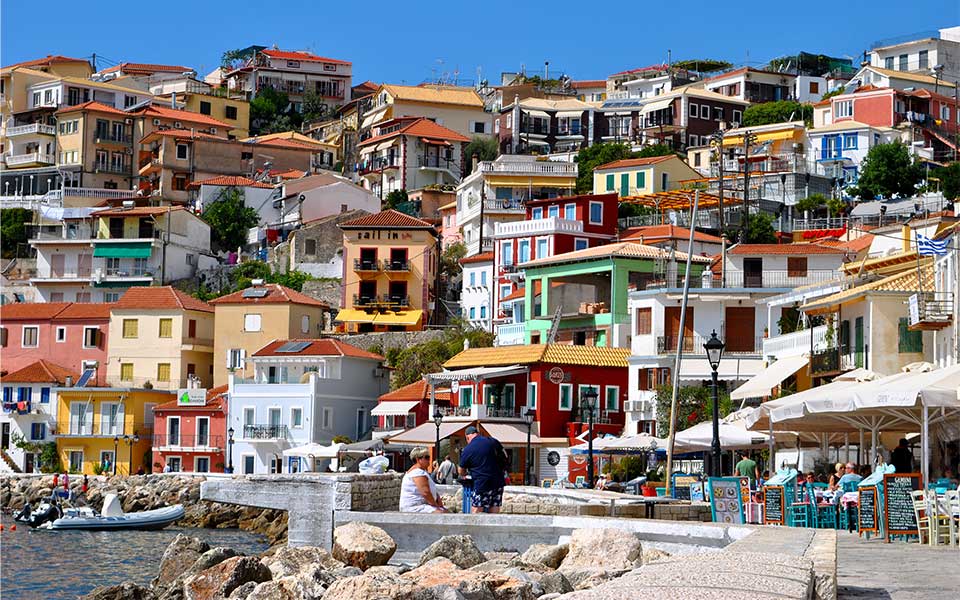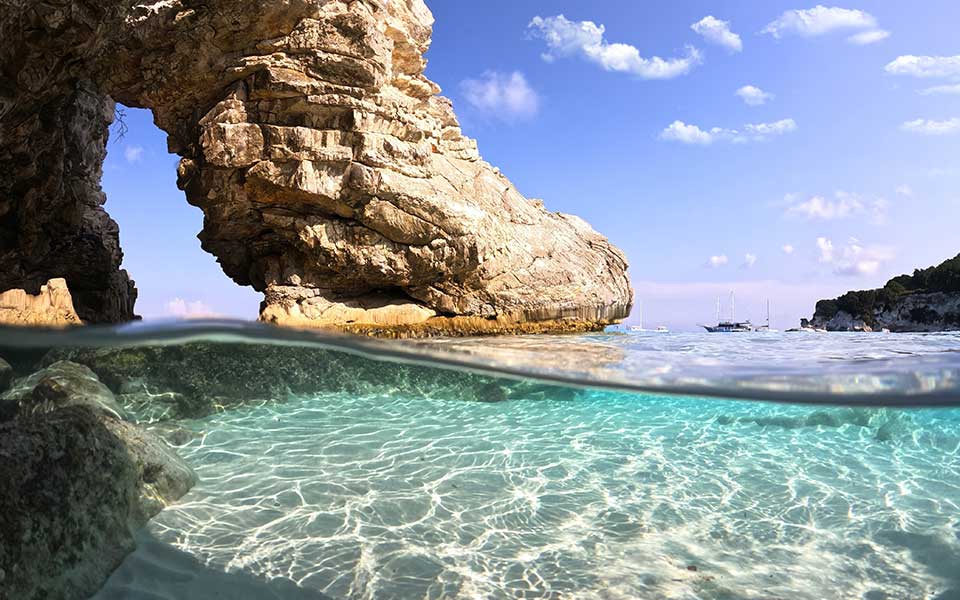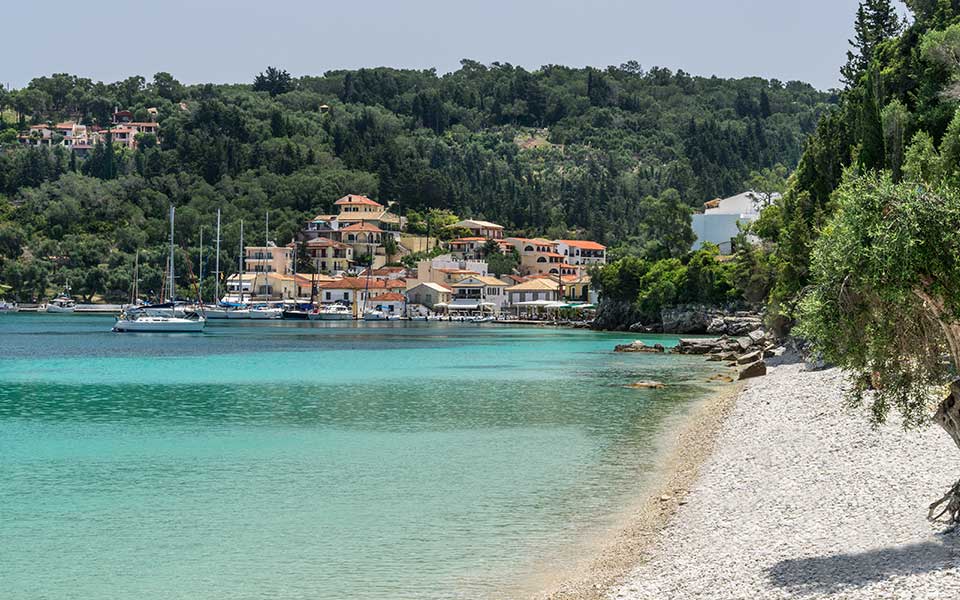Certain places in Greece make you feel like you’re in an earthly paradise. Voutoumi Beach on Antipaxos is undoubtedly one of them. However, this is not the only reason to spend a few days in Paxos, the gem of the Ionian Islands. Paxos’ sheltered coves with turquoise crystal-clear waters, picturesque villages nestled among pine trees and Venetian olive trees, caves, and breathtaking cliffs have won devoted friends who are reluctant to leave its tranquility. If you enjoy nature, swimming, bottlenose dolphins, and Ionian architecture, whether you own a boat or not, this year you have three more reasons to visit the site of Poseidon’s love affair with the sea goddess Amphitrite.

© Shutterstock
1. Jet-Setting at the Locations Where Maestro Was Filmed
Over the last year, the idyllic landscapes featured in Christoforos Papakaliatis’ series Maestro (or Maestro in Blu for the English-speaking audience) have brought Paxos to the attention of international set-jetters who travel to the locations of their favorite TV and film scenes. If you’re a fan of the series, Maestro could be the perfect excuse to discover the place where it was filmed.
In Gaios, you can see the port where music teacher Orestes arrives to organize a festival during the pandemic. You’ll recognize the stone pier at the harbor’s edge, where Haris Alexiou sings her “Prayer,” accompanied by an orchestra conducted by the maestro and surrounded by an audience watching from boats. You’ll also see the square, the Town Hall, the Museum, an old house with green shutters, and the bar where young Klelia hangs out. You will visit the Monastery of Panaghia Vellianiton on the islet of the same name to the left of Gaios’ entrance, as well as the islet of Aghios Nikolaos, where certain scenes, such as Charalambos’ murder, are set.
Further north, about seven kilometers from Gaios port, you will find the picturesque Lakka, the island’s second largest port, where you can see the orange building of the old school that housed Orestes’ music lessons and parts of the festival. Erimitis Beach, on the island’s west side, is surrounded by spectacular white cliffs and serves as the setting for one of Orestes and Klelia’s most important romantic scenes. It is one of the few beaches on Paxos’ western coast, featuring white pebbles and turquoise water. From here, you can see one of the island’s most stunning sunsets.

© Shutterstock
2. Swimming at the 5th Best Beach in the World
It only takes one swim in the crystal-clear waters of this exotic beach to understand why Voutoumi is now ranked as one of the world’s top 50 beaches. Thousands of tourism professionals ranked this small, fairytale-like Ionian coast fifth in Banana Boat’s The World’s 50 Best Beaches list, introducing its charm to travelers all over the world. If you haven’t already had the opportunity to enjoy the tranquility of this stunning beach, do so while it retains its unspoiled natural beauty.
Thankfully, the Paxos-Antipaxos island complex remains accessible only by sea (the nearest airport is in Corfu) and has been designated a Special Protection Area under the Natura 2000 network, allowing it to avoid the overtourism that has plagued other parts of the country. Voutoumi can be reached via private boat or small vessel from Gaios, Paxos’ port, followed by a short walk to the beach. The best time to visit is, of course, early in the morning before the horizon fills with boats, and the best months are May through June or September through October.
Aside from Voutoumi on Antipaxos, you can visit the beaches of Vrika, Mesavrika, and Rodovani. Paxos offers more options. Apart from the sandy beach in Mongonissi, most beaches are covered in white pebbles and hidden behind lush green hillsides. Some of the most impressive are Harami, Kipos, Kipiadi, Orkos, and Erimitis, one of Greece’s newest beaches formed by a landslide in 2008. The Blue Caves, Ypapanti Cave, and Tripitos Arch are also accessible by boat.

© Shutterstock
3. The 38th Paxos Festival
The cosmopolitan Ionian island hosts a variety of summer cultural events, attracting visitors from Greece and around the world. This year’s Paxos Festival, now in its 38th year, will feature unexpected musical encounters between medieval and contemporary music, the harp and rebetiko, and the bandoneon and classical guitar, with works by composers from various eras and regions of the world performed from June to October.
Additionally, the festival, which has evolved into a cultural institution, hosts art exhibitions, talks, and even hikes along ancient footpaths. To commemorate the 150th anniversary of the first Impressionist art exhibition in Paris in 1874, art historian Chris Boïcos will present lectures on the emergence of Impressionism in the courtyard of Longos’ former Primary School. Furthermore, the Paxos Festival will present “Quadrupeds,” a group painting exhibition curated by Elvira Metallinou, featuring works by contemporary Greek painters. Finally, visitors to Paxos who enjoy hiking will be able to learn about the island’s history through organized walks along forgotten footpaths that will take them to the islet of Aghios Nikolaos and the Venetian Fortress, as well as the Ancient Olive Trees and Stone Carved Cisterns around Gaios, Ypapanti and Kamara.
For more information, visit paxosfestival.com.












